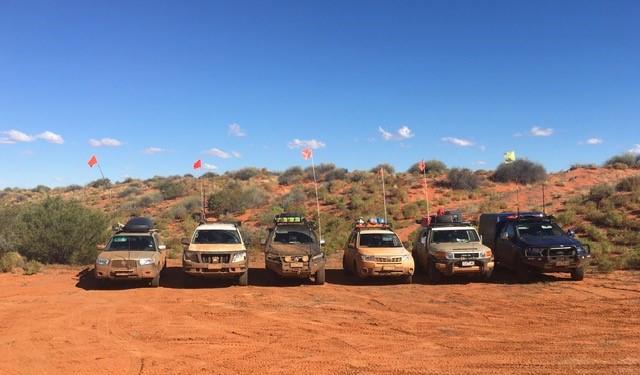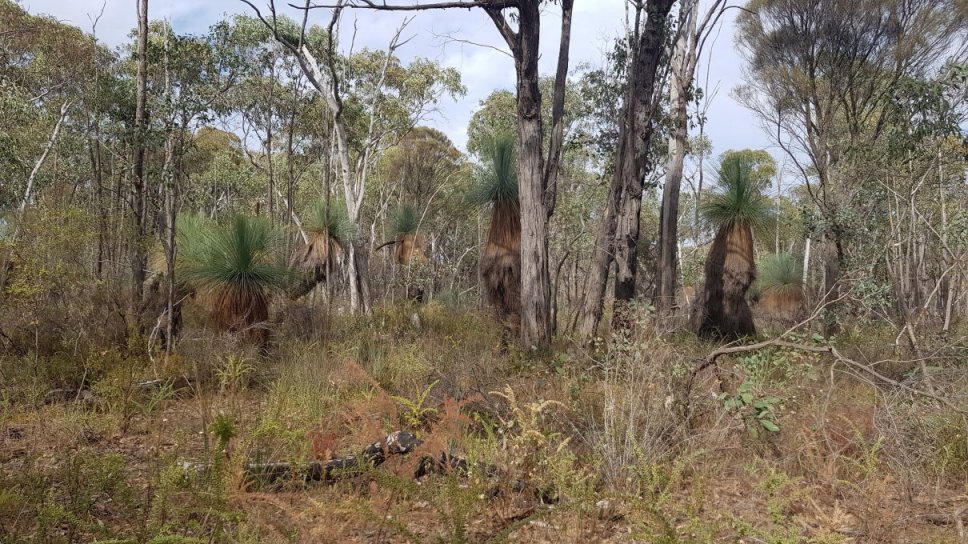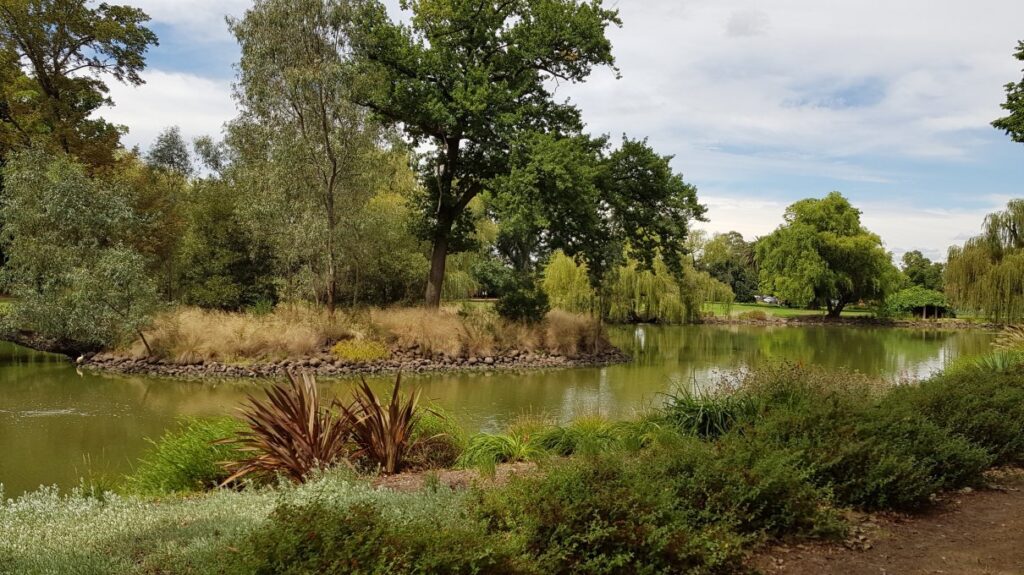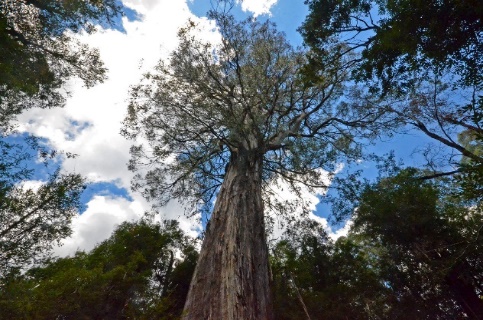Winter Dinner – June
A few of us got the together for a winter’s dinner at Jean and Peter’s place. It was bring a meal to share. We had kangaroo and emu, a Persian dish, a delightful vegetarian dish and some soup for entry. There was a large range of desserts to satisfy the most discerning sweet tooth. A good time was had by all.
There is no newsletter trip report for this trip

Simpson Desert revisited – June
Waiting on trip report – I will update when that is available
See newsletter #44, September 2022 for the full trip report
Wombat State Park – April/May
This was a weekend away staying at Lerderderg Campground. The first night the rain hammered down and the wind was quite strong. By the morning the rain had stopped. We headed out on Diggers Track. The track descended sharply over Sardine Creek, and we started the steep climb on the northern side. The track was rocky and had been made slippery by the overnight rain. We decided that it was not worth pushing ahead and we went in search for something a little easier.
Ambler Lane Track which was further west on the other side of the Lerderderg River which was crossed at O’Brien’s Crossing. We walked down to the river and to Point Tunnel, where the Lerderderg River was diverted through a fissure in the rock by miners to expose a large section of the riverbed for gold mining.
Back to the vehicles and the rest of the traverse along Amblers Lane Track. This occupied the group until lunch. There were many stops to inspect the numerous brown puddles that had probably expanded and deepened during the night. We ended up in Trentham for lunch.
After lunch we headed down Ottie Track. This had only just been opened after tree damage closed it. It was very slippery and one vehicle had to be recovered. Back at camp a good night was had in front of a fire.
See newsletter #40, May 2022 for the full trip report

Wangaratta
We did an Easter trip up to Wangaratta and the surrounding area. We stayed at Wenhams Campground in Ovens-Warby National Park. The first day we had a drive around the park. There are some amazing grass trees along Adams Road. We went to Pine Gully Picnic area and did the walk to the lookout. There was no water in the water fall with it being only the start of autumn. However the walk was nice and the view was lovely. We considered the Pangarang Lookout walk, but we didn’t think we had enough energy to do both walks.
Instead we went to Warby Tower lookout. The tower is no longer there, just the remnants of where it was, but the views are good. We had lunch at Spring Creek Picnic area.
Then we went to Killawarra to get the the Ovens River. We left the highway, and crossed the bridge over a creek and onto Hills Track. We had a nice drive along the river via Wilsons Track and Ovens Track. The tracks are easy with the occasional pot hole and rut to avoid. There are many campgrounds along the river. All but one had people in them, but given that it was Easter, they were not especially packed. The river drive is very scenic.
On the way back to camp we stopped and did Ryan’s Lookout. This is a short walk up to a tower where there are great views. Then it was back to camp for dinner and a chat around the fire.
The next day we went into Benalla and had morning tea at the art gallery. This is a very beautiful spot overlooking the lake. Then we followed this up with a bit of a walk around the town to admire the street art.
We went off to Winton Wetlands and had a late lunch at the outlet channel of Lake Mokoan. We had a drive through the wetlands and stopped on top of Green Hills for a cuppa. Snakes were a plenty. One of our party saw a brown snake, while another person saw a red bellied black snake. Neither snake hung around for a photo opportunity and were gone like a rocket. We went past the Art water tank and went down Nelson Road to the parks exit. Then back to camp for dinner and another fire.
The next day we headed out past Wangaratta to Eldorado to have a look at the dredge.


The Cocks Eldorado Dredge is moored in a little river siding. We had a looked around the dredge, which was 64 metres long, 20 metres wide at the stern and 50 metres wide at the bow. The whole dredge weighed 1880 tonnes. We did a walk around the lake where the dredge is. It’s definitely work a look and it is quite informative.
We went into Eldorado itself and had coffee at the general store. Went and brought a few pieces of pottery at the pottery place. Then we had lunch at the suspension bridge.
We then picked up the silo art trail and had a look at the art work there. We have previously run a trip here before, see “Painted Silos of North East Victoria 2021”
We had afternoon tea at Tungamah Weir. This is a lovely camping ground, which was busy, but not packed. We followed the Devenish road back to Goorambat where the Uniting Church was open so we could see the amazing art work of St Sophia, as well as the silo art work just up the road.
After this it was back to camp for dinner and another fire.
See newsletter #44, September 2022 for the full trip report
Pyrenees – March
We have visited Avoca and Moonambel quite a few times. The area has some very good wineries, scenic spots and great 4WD tracks. Many of the track have had little or no maintenance over the last 8 or so years. This has made the difficult tracks extreme and the extreme tracks – well, still extreme.
So we were a little circumspect where we went. We did Landsbrough Ridge Track. It has a short section that was a few washouts. One of the vehicles with us got stuck with his tow bar on a rock. Because of the steep slope and the angle of his vehicle, it was not a simple recovery and it took about an hour to get him going again. At the top we found a survey marker with an interesting nomination for the fine. We returned back to camp along Blue Mountain Track and Cactus Track. Both of these tracks were in very good condition.
The Next day we went north into Kara Kara National Park. The tracks from Moonambel campground to the park were a bit of a mixed bag. A little more rutted than I remember from last time, but in general not too bad. We headed along Centre Road and turned off on Blue Gum Track. A large section of this track looked like a dry river bed as it was mostly exposed rock. It was firm rock, so easy going, but a unusual sight to see.


We followed this to Teddington Track, past the hut to to the Teddington Reservoir. We had lunch here and a walk around the lower reservoir. After lunch we headed to the New England Range fire tower. It is a great view.
On the return back to camp, Once out of the National Park, we returned to camp via Long Gully Track and Bridle Track. There has been a lot of work done on the two hairpin turns along Long Gully. The bends have a spot where larger vehicle can back into to do a three point turn, and the approach is a lot better.
The next day we did a few tracks just north of the campground. Some sections proved a little too much for my vehicle, and other were certainly a challenge.
See newsletter #41, May 2022 for the full trip report

Castlemaine – March
We stayed at Leanganook Campground at Mt Alexander. We took a drive up to the cairn at the top of the mountain, then to Dog Rocks lookout. We dropped into to one of the old quarries for a quick look. Then we went to the Oaks for morning tea and lunch. We took a drive to the old Welsh Village and had a walk around there.
The next day we went to the Garfield water wheel and then the Botanical Gardens for lunch. In the afternoon we drove to the top of The Monk and did a few other 4WD tracks.
See newsletter #39, April 2022 for the full trip report

Cheese Making – February
After a bit of a delay due to COVID, the cheese making day finally went ahead. Fetta was the first cheese for the day. We heated the milk to the correct temperature then the starter, calcium and rennet were added and the container was covered with towels. 90 minutes later we cut the curd and left it for another 30 minutes. The curds were gently turned to break them up before scooped into the hoops to drain.
Next it was Blue cheese. This would need to be finished off at home and it would take about 3 months for the mold to grow.
See newsletter #38, March 2022 for the full trip report

Yarra State Forest – Australia Day
The trip started in Warburton. We started along Riverside Drive, a short picturesque drive along the Yarra River. We followed Big Pat’s Creek Road before turning left onto Smyth Creek Road to Stirling Gap. We continued driving through areas of large tree ferns and everyone just enjoying being out in the bush. We soon arrived at the Ada Tree car park. Some did the 3km walk to the tree.
After lunch we took the New Turkey Spur Road to come out onto the Yarra Junction Noojee Road and turned right to make our way into Powelltown.
We stopped in Powelltown for ice creams. We then turned left onto the Learmouth Creek Road and made our way to the Seven Acre Rock. This was a pleasant walk through the bush and then a bit of scrambling over rocks to get to the lookout.
The rain came, and e got as bit wet walking back tot he car. We travelled along the Bunyip Road and onto the East Beenak Road. The bush around us took on a new kind of beauty with the rain and the steam rising off the roads. By the time we entered Kurth Kiln Regional Park the rain and stopped.
We arrived at Kurth Kiln for afternoon tea. During the 2nd World War, due to petrol shortages, the kiln was built to burn timber for charcoal which was then used to produce gas to run vehicles. There was also housing built for the timber workers and those working on the kiln.
See newsletter #37, February 2022 for the full trip report


Canunda National Park – Australia Day
This was a fixed camp staying at Oil Rig Square campground in Canunda National Park. The campground is accessible by a 2WD road and is suitable for tents, campers and medium size caravans. It is situated in the middle of the park and close to Millicent, maybe about 15km.
Wednesday: we headed down to Geltwood beach and headed north along the beach. We went inland at the first track off the beach. The inland track is a bit of mixed bag, with mostly hard packed sand, some rocky sections and a few dunes with some soft sand.
The coastal views here are spectacular, with some of the best scenery available in Australia. There are rock pools and swimming holes, caves cliffs and island rocks just off the coast. There are a few tracks that go out to McIntyre Beach, and they are well worth taking.
We had lunch at Southend, where it poured with rain for about 15 minutes. We stood under a shelter and ate. We then headed back to camp via Khyber Pass Track. It was a pleasant drive, but it was not the most direct route route back to camp and left a bit of a loop along a couple of 2WD roads.
Thursday: today we were going to look at the southern end of the park. Our stop was to Coola outstation. There is not much there, but the place had an interesting history. There were some walking tracks down to the Lake Bonney (and possibly a 4WD track also), but we did not have a lot of time to spend there.
The land here was very stark and windswept. It was reminiscent of photos of Mars surface. We took the track to Whale Rock Soak, but at the end of the track, we could not really work out what we were looking at. We headed back to the main track and then up to the wind farm lookout over Lake Bonney.
At No. 2 Rocks there is a gorgeous lagoon to swim in. It is well worth putting in a mask and snorkel as there is a patch of sea weed that is very beautiful. It has different types with different colours.
We ended up at the Cape Banks Lighthouse. We aired up and took the highway back to camp.


Friday: today we were going to do a few of the more touristy things. We drove down the wind farm scenic drive on the way to Tantaloona cave (south of Millicent). The cave is not very large, but it is full of interesting and beautiful things to look at. There are stalactites, stalagmites, columns and shawls. It was found in 1930 and it is wheel chair accessible.
Morning tea was at Beachport where some people had a walk along the jetty, while other brought fish and lobster.. Then we headed to Robe, stopping at Woakwine cutting. This is an impressive cutting to drain a swamp into a neighbouring lake to make the land farmable. It was done in the late 1950s using a D7 tractor. The cutting is 1km long and 28m at its deepest point.
We then went for a short drive in Little Dip Conservation Park.
See newsletter #37, February 2022 for the full trip report